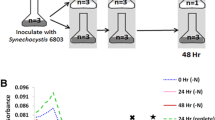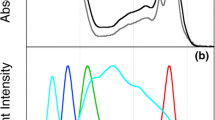Abstract
Far-Red Light (FRL) acclimation is a process that has been observed in cyanobacteria and algae that can grow solely on light above 700 nm. The acclimation to FRL results in rearrangement and synthesis of new pigments and pigment-protein complexes. In this study, cyanobacteria containing chlorophyll f, Synechococcus sp. PCC 7335 and Halomicronema hongdechloris, were imaged as live cells with confocal microscopy. H. hongdechloris was further studied with hyperspectral confocal fluorescence microscopy (HCFM) and freeze-substituted thin-section transmission electron microscopy (TEM). Under FRL, phycocyanin-containing complexes and chlorophyll-containing complexes were determined to be physically separated and the synthesis of red-form phycobilisome and Chl f was increased. The timing of these responses was observed. The heterogeneity and eco-physiological response of the cells was noted. Additionally, a gliding motility for H. hongdechloris is reported.




Similar content being viewed by others
Abbreviations
- 1D:
-
One day
- 3W:
-
Three weeks
- APC:
-
Allophycocyanin
- Chl:
-
Chlorophyll
- FaRLiP:
-
Far-red light photoacclimation
- FRL:
-
Far-red light
- H. hongdechloris :
-
Halomicronema hongdechloris
- HCFM:
-
Hyperspectral confocal fluorescence microscopy
- MCR:
-
Multivariate curve resolution
- PBS:
-
Phycobilisome
- PC:
-
Phycocyanin
- PS:
-
Photosystem
- PSI:
-
Photosystem I
- PSII:
-
Photosystem II
- Syn 7335:
-
Synechococcus sp. PCC 7335
- TEM:
-
Transmission electron microscopy
- WL:
-
White light
References
Akimoto S, Shinoda T, Chen M et al (2015) Energy transfer in the chlorophyll f-containing cyanobacterium, Halomicronema hongdechloris, analyzed by time-resolved fluorescence spectroscopies. Photosynth Res 125:115–122. doi:10.1007/s11120-015-0091-3
Behrendt L, Larkum AW, Norman A et al (2011) Endolithic chlorophyll d-containing phototrophs. ISME J 5:1072–1076. doi:10.1038/ismej.2010.195
Behrendt L, Brejnrod A, Schliep M et al (2015) Chlorophyll f-driven photosynthesis in a cavernous cyanobacterium. ISME J 9:2108–2111. doi:10.1038/ismej.2015.14
Chen M (2014) Chlorophyll modifications and their spectral extension in oxygenic photosynthesis. Annu Rev Biochem 83:317–340. doi:10.1146/annurev-biochem-072711-162943
Chen M, Blankenship RE (2011) Expanding the solar spectrum used by photosynthesis. Trends Plant Sci 16:427–431
Chen M, Schliep M, Willows RD et al (2010) A red-shifted chlorophyll. Science 329:1318–1319. doi:10.1126/science.1191127
Chen M, Li Y, Birch D, Willows RD (2012) A cyanobacterium that contains chlorophyll f: a red-absorbing photopigment. FEBS Lett 586:3249–3254. doi:10.1016/j.febslet.2012.06.045
Collins AM, Liberton M, Jones HDT et al (2012) Photosynthetic pigment localization and thylakoid membrane morphology are altered in Synechocystis 6803 phycobilisome mutants. Plant Physiol 158:1600–1609. doi:10.1104/pp.111.192849
Dahl R, Staehelin LA (1989) High-pressure freezing for the preservation of biological structure: Theory and practice. J Electron Microsc Tech 13:165–174. doi:10.1002/jemt.1060130305
Fork DC, Larkum AWD (1989) Light harvesting in the green alga Ostreobium sp., a coral symbiont adapted to extreme shade. Mar Biol 103:381–385. doi:10.1007/BF00397273
Gan F, Bryant DA (2015) Adaptive and acclimative responses of cyanobacteria to far-red light. Environ Microbiol 17:3450–3465
Gan F, Shen G, Bryant D (2014a) Occurrence of far-red light photoacclimation (FaRLiP) in diverse cyanobacteria. Life 5:4–24. doi:10.3390/life5010004
Gan F, Zhang S, Rockwell NC et al (2014b) Extensive remodeling of a cyanobacterial photosynthetic apparatus in far-red light. Science 345:1312–1317. doi:10.1126/science.1256963
Gantt E (1981) Phycobilisomes. Annu Rev Plant Physiol 32:327–347. doi:10.1146/annurev.pp.32.060181.001551
Gilkey JC, Staehelin LA (1986) Advances in ultrarapid freezing for the preservation of cellular ultrastructure. J Electron Microsc Tech 3:177–210. doi:10.1002/jemt.1060030206
Grossman AR, Schaefer MR, Chiang GG, Collier JL (1993) The phycobilisome, a light-harvesting complex responsive to environmental conditions. Microbiol Rev 57:725–749. doi:10.1007/s11120-010-9573-5
Gutu A, Kehoe DM (2012) Emerging perspectives on the mechanisms, regulation, and distribution of light color acclimation in cyanobacteria. Mol Plant 5:1–13. doi:10.1093/mp/ssr054
Haaland D, Jones HDT, Timlin J (2016) Chap. 12: Experimental and data analytical approaches to automating multivariate curve resolution in the analysis of hyperspectral images. In: Ruckebusch C (ed) Data handling in science and technology, Elsevier, Amsterdam pp 381–408
Ho M-Y, Shen G, Canniffe DP et al (2016) Light-dependent chlorophyll f synthase is a highly divergent paralog of PsbA of photosystem II. Science. doi:10.1126/science.aaf9178
Ho MY, Gan F, Shen G et al (2017a) Far-red light photoacclimation (FaRLiP) in Synechococcus sp. PCC 7335: I. Regulation of FaRLiP gene expression. Photosynth Res 131:173–186. doi:10.1007/s11120-016-0309-z
Ho MY, Gan F, Shen G, Bryant DA (2017b) Far-red light photoacclimation (FaRLiP) in Synechococcus sp. PCC 7335. II. Characterization of phycobiliproteins produced during acclimation to far-red light. Photosynth Res 131:187–202. doi:10.1007/s11120-016-0303-5
Hou HJM, Allakhverdiev SI, Najafpour MM (2014) Plant Physiology Current challenges in photosynthesis: from natural to artificial current challenges in photosynthesis. Front Plant Sci 5:232. doi:10.3389/fpls.2014.00232
Jones HDT, Haaland DM, Sinclair MB et al (2012) Preprocessing strategies to improve MCR analyses of hyperspectral images. Chemom Intell Lab Syst 117:149–158. doi:10.1016/j.chemolab.2012.01.011
Kühl M, Chen M, Ralph PJ et al (2005) A niche for cyanobacteria containing chlorophyll d. Nature 433:2005–2005. doi:10.1038/433820a
Li Y, Scales N, Blankenship RE et al (2012) Extinction coefficient for red-shifted chlorophylls: chlorophyll d and chlorophyll f. Biochim Biophys Acta 1817:1292–1298. doi:10.1016/j.bbabio.2012.02.026
Li Y, Cai ZL, Chen M (2013) Spectroscopic properties of chlorophyll f. J Phys Chem B 117:11309–11317. doi:10.1021/jp402413d
Li Y, Lin Y, Loughlin PC, Chen M (2014) Optimization and effects of different culture conditions on growth of Halomicronema hongdechloris: a filamentous cyanobacterium containing chlorophyll f. Front Plant Sci 5:67. doi:10.3389/fpls.2014.00067
Li Y, Lin Y, Garvey CJ et al (2016) Characterization of red-shifted phycobilisomes isolated from the chlorophyll f-containing cyanobacterium Halomicronema hongdechloris. Biochim Biophys Acta 1857:107–114. doi:10.1016/j.bbabio.2015.10.009
Liu H, Zhang H, Niedzwiedzki DM et al (2013) Phycobilisomes supply excitations to both photosystems in a megacomplex in cyanobacteria. Science 342:1104–1107. doi:10.1126/science.1242321
Majumder EL-W, Olsen JD, Qian P et al (2016) Supramolecular organization of photosynthetic complexes in membranes of Roseiflexus castenholzii. Photosynth Res. doi:10.1007/s11120-015-0179-9
Miyashita H, Ikemoto H, Kurano N et al (1996) Chlorophyll d as a major pigment. Nature 383:402–402
Niedzwiedzki DM, Liu H, Chen M, Blankenship RE (2014) Excited state properties of chlorophyll f in organic solvents at ambient and cryogenic temperatures. Photosynth Res 121:25–34. doi:10.1007/s11120-014-9981-z
Raymond J, Swingley WD (2008) Phototroph genomics ten years on. Photosynth Res 97:5–19
Schindelin J, Arganda-Carreras I, Frise E et al (2012) Fiji: an open-source platform for biological-image analysis. Nat Methods 9:676–682. doi:10.1038/nmeth.2019
Sinclair MB, Haaland DM, Timlin JA, Jones HDT (2006) Hyperspectral confocal microscope. Appl Opt 45:6283. doi:10.1364/AO.45.006283
Studer D, Hennecke H, Müller M (1992) High-pressure freezing of soybean nodules leads to an improved preservation of ultrastructure. Planta 188:155–163. doi:10.1007/BF00216809
Tomo T, Shinoda T, Chen M et al (2014) Energy transfer processes in chlorophyll f-containing cyanobacteria using time-resolved fluorescence spectroscopy on intact cells. Biochim Biophys Acta 1837:1484–1489. doi:10.1016/j.bbabio.2014.04.009
Van Benthem MH, Keenan MR (2004) Fast algorithm for the solution of large-scale non-negativity-constrained least squares problems. J Chemom 18:441–450. doi:10.1002/cem.889
Van Benthem MH, Keenan MR, Haaland DM (2002) Application of equality constraints on variables during alternating least squares procedures. J Chemom 16:613–622. doi:10.1002/cem.761
Vermaas WFJ, Timlin JA, Jones HDT et al (2008) In vivo hyperspectral confocal fluorescence imaging to determine pigment localization and distribution in cyanobacterial cells. Proc Natl Acad Sci 105:4050–4055. doi:10.1073/pnas.0708090105
Willows RD, Li Y, Scheer H, Chen M (2013) Structure of chlorophyll f. Org Lett 15:1588–1590. doi:10.1021/ol400327j
Wolf BM, Niedzwiedzki DM, Magdaong NCM et al (2017) Characterization of a newly isolated freshwater Eustigmatophyte alga capable of utilizing far-red light as its sole light source. Photosynth Res. doi:10.1007/s11120-017-0401-z
Xu M, Kinoshita Y, Tamiaki H (2014) Synthesis of chlorophyll-f analogs possessing the 2-formyl group by modifying chlorophyll-a. Bioorg Med Chem Lett 24:3997–4000. doi:10.1016/j.bmcl.2014.06.022
Yamanaka G, Glazer A (1980) Dynamic aspects of phycobilisome structure. Arch Microbiol 7:39–47. doi:10.1007/BF00407026
Yokoo R, Hood RD, Savage DF (2015) Live-cell imaging of cyanobacteria. Photosynth Res 126:33–46
Acknowledgements
This work was supported as part of the Photosynthetic Antenna Research Center (PARC), an Energy Frontier Research Center funded by the U.S. Department of Energy, Office of Science, Basic Energy Sciences under Award #DE-SC0001035”. The authors are grateful to Michael Sinclair for the use and maintenance of the hyperspectral confocal fluorescence microscope, Stephen Anthony for the current implementation of the MCR analysis software used to deconvolve spectral components; Howland Jones, Mark Van Benthem, David Melgaard, Mike Keenan, and David Haaland for original development of the MCR algorithm and software. Sandia National Laboratories is a multi-mission laboratory managed and operated by National Technology and Engineering Solutions of Sandia, LLC, a wholly owned subsidiary of Honeywell International, Inc., for the U.S. Department of Energy’s National Nuclear Security Administration under contract DE-NA0003525. E.L.-W.M. acknowledges graduate fellowships Mr. and Mrs. Spencer T. Olin Fellowship for Women and the P.E.O. Scholar Award.
Author information
Authors and Affiliations
Corresponding author
Electronic supplementary material
Below is the link to the electronic supplementary material.
Rights and permissions
About this article
Cite this article
Majumder, E.LW., Wolf, B.M., Liu, H. et al. Subcellular pigment distribution is altered under far-red light acclimation in cyanobacteria that contain chlorophyll f . Photosynth Res 134, 183–192 (2017). https://doi.org/10.1007/s11120-017-0428-1
Received:
Accepted:
Published:
Issue Date:
DOI: https://doi.org/10.1007/s11120-017-0428-1




